
|
|
Malankara World Journal
Theme: 1st Sunday After New Sunday Volume 6 No. 343 April 8, 2016 |

|
|
Malankara World Journal
Theme: 1st Sunday After New Sunday Volume 6 No. 343 April 8, 2016 |
|
IV. This Week's Supplement
Tribute to V. Rev. Joseph Pukkunnel and Mother Angelica |
|
God, grant me the serenity to accept the things I cannot change;
courage to change the things I can; and wisdom to know the difference. Living one day at a time; Enjoying one moment at a time; Accepting hardships as the pathway to peace; Taking, as He did, this sinful world as it is, not as I would have it; Trusting that He will make all things right if I surrender to His Will; That I may be reasonably happy in this life and supremely happy with Him Forever in the next. Amen. Reinhold Niebuhr |
|
by John MacArthur "Blessed are those who mourn, for they shall be comforted"Human sorrow is a natural and healthy emotion, but beware of mourning over unfulfilled sinful desires. Most people in our society have an amusement-park mentality. They spend much of their time and money on entertainment, wanting to enjoy life and avoid problems whenever possible. To them, Matthew 5:4 is a paradox. How can someone who mourns be happy? The answer lies in the difference between godly sorrow and human sorrow. Godly sorrow is sorrow over sin; human sorrow is sorrow over some tragic or disappointing turn of events (2 Cor. 7:8-11). In Matthew 5:4, Jesus is referring to godly sorrow. But we all face human sorrow, so I want to discuss it briefly today. Human sorrow is a natural emotion. Our Lord Himself was "a man of sorrows, and acquainted with grief" (Isa. 53:3). Many things can cause it: we might mourn out of love, disappointment, loneliness, or physical illness. There is nothing wrong with that kind of mourning. It is a God- given relief valve for the pain and sorrow in this fallen world, and promotes the healing process. Scripture gives many examples of human sorrow. Abraham wept when his wife, Sarah, died (Gen. 23:2). Through tears Jeremiah preached God's message of judgment (Jer. 9:1). Paul expressed his concern for the church with his tears (Acts 20:31). Those are natural, healthy expressions of human sorrow. However, sorrow can also be caused by evil desires or a lack of trust in God. King Ahab mourned to the point of sulking and not eating when he couldn't have another man's property (1 Kings 21:4). Some Christians mourn excessively when they lose a loved one. Forsaking the comfort of the Spirit, they focus only on their own grief. Extreme or prolonged manifestations of sorrow are sinful and must be confessed rather than comforted. God is gracious to His children amid times of human sorrow. Ultimately He will do away with mourning and pain forever (Rev. 21:4). Rejoice in that promise and be comforted by His wonderful grace! Suggestions for Prayer Thank God for the ministry of the Spirit, who is the great Comforter or Helper (John 14:16-17). When sorrow occurs, lean on the Spirit, feed your soul on God's Word, and commune with Him in prayer. For Further Study Read Psalm 55. How did David express his desire to escape his difficult situation? What was his final resolve? Source: Grace to You.org |
|
by Msgr. Charles Pope The recent death of Mother Angelica provoked the expected sadness at the passing of such a great woman. Indeed, her vivacious and plain-spoken presence has long been missed during these years of her declining health. She called this her time of purgatory and purification. In an extraordinary grace, the Lord called her at 5:00 PM on Easter Sunday, likely the very time at which He was making His first appearances to His disciples at Emmaus and in Jerusalem. For the faithful - and Mother Mary Angelica was surely that - the day we die is the greatest day of our life on this earth. And even if some final purifications await us, the beatific vision for which we long lies just ahead; the exile in this valley of tears is ended. Is calling the day we die the greatest day of our life too strong a statement? I have seen some fellow Christians wince when I say this. But in this age of emphasis on worldly comforts, medicine, and the secular, this age in which we rarely speak of Heaven (or Hell), I wonder if we have lost some of our longing for Heaven and cling too strongly to the trinkets of this life. I attended the funeral of the relative of a family friend some years ago. She was an unbeliever, a self-described secular humanist, and she made the following comment to me: "Perhaps there is Heaven for the faithful who believe there is life after death. And perhaps, then, to die is the greatest day of their life. But I do not observe that Christians live this way. It seems to me that they are as anxious as anyone else about dying, and earnestly seek to avoid death just as much as anyone else." It was a very interesting observation, one that I found mildly embarrassing even as legitimate explanations quickly entered my mind. And even after giving her some of those explanations, I must say that some of the embarrassment lingered as to the kind of witness we Christians sometimes fail to give to our most fundamental values. Based on her remark - and I've heard it before - most of us Christians don't manifest a very ardent longing for Heaven. There are, of course, some legitimate reasons that we do not rush towards death; there are also some less legitimate reasons. In this post, I'd like to briefly speak to some of these. Here are some legitimate and understandable reasons that we may draw back from dying, and may not at first think of dying is the greatest day of our life: 1. There is a natural fear of dying that is part of our physical makeup and, it would seem, hard-wired into our psyche as well. Every sentient and physical being on this planet, man or animal, has a strong instinct for survival. Without this instinct, strongly tied to both hunger and sexual desire, we might not only die as individuals but as a species. It also drives us to look to the future, as we work to ensure the survival, even thriving, of our children and those who will come after us. So this is a basic human instinct that we ought not to expect to disappear, because it has necessary and useful aspects. 2. Most of us would like to finish certain important things before we die. It makes sense, for example, that parents would like to see their children well into adulthood before meeting their demise. Parents rightly see their existence in this world as critical to their children. Hence we love life here and cling to it not just for our own sake, but because we understand that others depend on us. 3. The Christian is called to love life at every stage. Most of us realize that we are called to love and appreciate what we have here, for it is the gift of God. To so utterly despise the world that we are almost suicidal and wish only to leave it, manifests a strange sort of ingratitude. It also manifests a lack of understanding that life here prepares us for the fuller life that is to come. I remember that at a low point in my own life, afflicted with anxiety and depression, I asked the Lord to please end my life quickly and take me home out of this misery. And yet, without hearing words, I felt the Lord's rebuke: "Until you learn to love the life you have now, you will not love eternal life. If you can't learn to appreciate the glory of the gifts of this life, then you will not and cannot embrace the fullness of life that is called eternal life." Indeed, I was seeing eternal life merely in terms of relief or escape from this life, rather than as the full blossoming of a life that has been healed and made whole. We don't embrace life by trying to escape from it. Thus a healthy Christian attitude learns to love life as we have it now, even as we yearn and strive for a life that we do not yet fully comprehend: a life that eye has not seen, nor ear heard; what God has prepared for those who love Him. 4. Most of us seek to set our life in order to some degree before we go to face judgment. While it is true that we can procrastinate, there is a proper sense of wanting time to make amends and to prepare in a fitting and growing way to meet God. 5. It is not necessarily death that we fear, but dying. Dying is something none of us has ever done before and we tend to fear the unknown. Further, most of us realize that dying itself involves some degree of agony. Instinctively and understandably, we draw back from such things. Even Jesus, in His human nature, recoiled at the thought of the agony before Him, so much so that He sweat blood and asked, if possible, that the cup of suffering be taken from him. Manfully, though, He embraced His Father's will, and our benefit rather than His. Still, He did recoil humanly at the suffering soon to befall Him. Despite this hesitancy to meet death, for a faithful Christian the day we die is the greatest day of our life. And while we ought to regard the day of our judgment with sober reverence, we should go with joyful hope to the Lord who loves us and for whom we have longed. That day of judgment, awesome though it is, will for the future saint disclose only that which needs final healing in purgation, not that which merits damnation. But we don't hear much longing for our last day on this earth or for God and Heaven. Instead we hear fretting about how we're "getting older." We're anxious about our health, even the natural effects of aging. And there are such grim looks as death approaches! Where is the joy one might expect? Does our faith really make a difference for us, or are we like those who have no hope? Older prayers referred to life on this earth as an exile and expressed a longing for God and Heaven. But few of today's prayers or sermons speak this way. Here are some of the not-so-legitimate reasons that we may draw back from dying: 1. We live comfortably. While comfort is not the same as happiness, it is very appealing. It is also very deceiving, seductive, and addictive. It is deceiving because it tends to make us think that this world can be our paradise. It is seductive because it draws and shifts us our focus away from the God of comforts to the comforts of God. We would rather have the gift than the Giver. It is addictive because we can't ever seem to get enough of it; we seem to spend our whole life working toward gaining more and more comforts. We become preoccupied by achieving rather than working toward our truest happiness, which is to be with God in Heaven. 2. Comfort leads to worldliness. Here, worldliness means focusing on making the world more comfortable while allowing notions of God and Heaven to recede into the background. Even the so-called spiritual life of many Christians is almost wholly devoted to prayers asking to make this world a better place: "Fix my health. Fix my finances. Grant me that promotion." And while it is not wrong to pray about these things, their cumulative effect, added to our silence on more spiritual and eternal things, gives the impression that we are saying to God, "Make this world a better place and I'll just be happy to stay here forever." What a total loss! This world is not the point; it is not the goal, Heaven is. Being with God forever is the point. 3. Worldliness makes Heaven and being with God seem more abstract and less desirable. With our magnificent comfort that leads to worldly preoccupation, Heaven and any talk of Heaven or going to be with God recedes to the background. In this climate, few speak of Heaven or even long for it. They'd rather just have that new cell phone or the cable upgrade with the sports package. Some say that they never hear about Hell anymore in sermons, and in many parishes (though not in mine, thank you) that is regrettably the case. But it is also true that they almost never of Heaven either (except in some cheesy funeral moments that miss the target altogether and make Heaven seem trivial rather than a glorious gift to be sought). Heaven just isn't on most people's radar, except as a vague abstraction for some far off time - certainly not now. This is the perfect storm of comfort and worldliness leading to slothful aversion to heavenly gifts. That may be why, when I say that dying is the greatest day of our life, or that I am glad to be getting older because it means I'm getting closer to the time I can go home to God, or that I can't wait to meet God, people look at me strangely and seem to wonder if I need therapy. No, I don't need therapy - at least not for this. I am simply expressing the ultimate longing of every human heart. Addiction to comfort has deceived and seduced us such that we are no longer in touch with our heart's greatest longing; we cling to passing things. I would argue (as does my family friend) that we seem little different from those who have no hope. We no longer witness to a joyful journey to God that says, "Closer to Home! … Soon and very soon I am going to see the King … Soon I will be done with the troubles of this world … Going home to live with God!" There are legitimate, understandable reasons for being averse to dying. But how about even a glimmer of excitement from the faithful as we see that our journey is coming to an end? St. Paul wrote the following to the Thessalonians regarding death: We do not want you to be like those who have no hope (1 Thess 4:13). Do we witness to the glory of going to be with God or not? It would seem not. The video below features a rendition of the hymn "For All the Saints Who from Their Labors Rest." Here is a brief passage from the lyrics: The golden evening brightens in the West,Soon, soon, to faithful warriors cometh rest. Sweet is the calm of Paradise most blest. Alleluia! Mother Mary Angelica, faithful warrior, rest in peace. Video https://youtu.be/1OaBgaMcOvM |
|
The world has lost the Poor Clare nun who changed the face of Christianity in
the United States and around the world. Mother Mary Angelica of the
Annunciation, foundress of the Eternal Word Television Network (EWTN), passed
away on March 27, 2016 after a lengthy struggle with the after-effects of a stroke.
She was 92 years old.
|
|
by Dr. Jacob Mathew, Malankara World V Rev. Pukkunnel Joseph Cor Episcopa has gone to his eternal home on 18 March 2016. He was 91 years old. He is survived by his wife Alice, 8 children and their spouses and numerous grand children.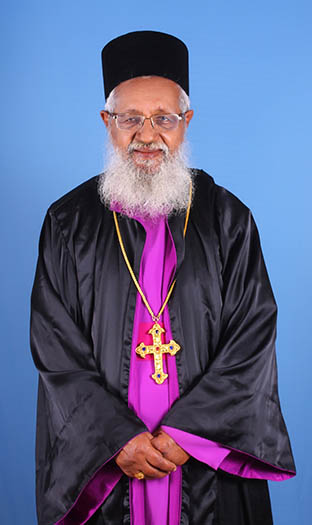 Fr. Joseph was born on 18 August 1925 as son of Thoma Mathai and Kunjamma Mathai of
Pukkunnel Family in Kothamangalam. He was the youngest of 7 children.
Education:
Passed ESLC exam in 1943 from Mar Basil High School.
Fr. Joseph was born on 18 August 1925 as son of Thoma Mathai and Kunjamma Mathai of
Pukkunnel Family in Kothamangalam. He was the youngest of 7 children.
Education:
Passed ESLC exam in 1943 from Mar Basil High School. Graduated in 1949 (BA) Passed MA - English in 1978 Educationist 1949 - 1981 - Teacher, St. Basil's School 1981 - Principal, St. Basil Higher Secondary School, Baroda, St. Thomas School, Kalyan Priesthood He was ordained as a deacon on 25 March 1944 by Saint Mar Athanasius Poulose, Metropolitan of Angamaly (Popularly known as 'Valia Thirumeni' - entombed in Thrikunnathu Seminary, Aluva). March 25 1944 was a special day in Church calendar. It was the day of annunciation to St. Mary (Suboro Feast). In 1944, March 25th coincided with the 40th day of Great Lent (beginning of Passion Week). During the ordination of young Joseph Pukkunnel, saint valia thirumeni has stated that he has never ordained anyone on such an important and auspicious day. It was indeed a great blessing and a rare honor. It was a clear signal that Deacon Joseph will be 'going places.' Deacon Joseph was ordained as a Priest on 8 May 1955 by HG Geevarghese Mar Gregoriose, Metropolitan of Angamali. His first Holy Eucharist (Puthen Qurbana) was celebrated on 11 Sep 1955 at St. Mary's Church, Kothamangalam. He was consecrated as a Cor Episcopa on May 20, 2006 by His Beatitude Aboon Mor Baselios Thomas 1, Catholicose of the East. Father Joseph's first appointment was as a vicar in St. Mary's Church, Thalakode in 1955. Since then he had served numerous churches. (see the below) Churches Served: St. Mary's Church, Thalakode St. Mary's Church, Kuttamangalam St. Mary's Church, Chathamattom St. George Church, Kumbanpara St. Mary's Church, Kallar St. Mary's Church, Munnar St. George Church, Ayankara St. George Church, Maramangalom Bes Ania Church, Chelad St. George Church, Kalkurish UC College Church, Aluva St. Mary's Church, Angamali Telc St. Mary's Church, Karakunnam St. Mary's Church, Mulavoor Mor Ignatius Church, Chenkara Bandra Church, Mumbai Malad Church, Mumbai Vapi Church, Mumbai Balsad Church, Mumbai Colaba Afghan Church, Mumbai Achen also constructed, remodeled and rebuilt numerous churches. Achen also was very active in charitable activities. He had led the efforts to build homes for poor people in several churches he served. Family: Wife: Alice, daughter of VC Thomas and Kuttiyamma, Vakkayil Family, Aleppey Children: Jane - Retd. Teacher, Fact School, Ambalamedu Jessy - Retd. Teacher, St. Peter's Higher Secondary School, Kadayiruppu Jimmy - Indian Expressm (Retd.), Ernakulam Joy - Dubai Jemima - Professor, KC College, Mumbai Jagan - Chief Manager, State Bank of Travancore Jijo - VP, Bank of America, Delaware, USA, ex- Archdiocesan Council member, Malankara Archdiocese, USA Jasmine - Dubai Spouses of Children: Jose Mathew, Kanjirathinkal (Retd. Supdt, Central Excise Shine V. Athithottam, Retd. Principal, St. Mary's Higher Secondary School, Thuruthipally Anie, Retd. Professor, St. Peters College, Kolencherry Latha, Teacher, Dubai Samuel Mathew, Assistant Commissioner, Central Excise, Mumbai Dr. Emi, San Maria Dental Clinic, Kothamangalam Sunitha Jijo Flowerhill, Data Architect, Delaware, USA. also Board Member, Malankara World Rajan Baby, Dubai Death and Funeral Interestingly, achen died on the 40th Friday of Great Lent in 2016. 2016 was unique because, the annunciation to St. Mary happened to coincide with Good Friday this year, a very rare event not to be repeated in 100 years! Jijo, achen's youngest son, told me that achen was looking forward to the 40th Friday of Great Lent this year -72nd anniversary of his ordination as a deacon - while confined to the hospital on his death bed. 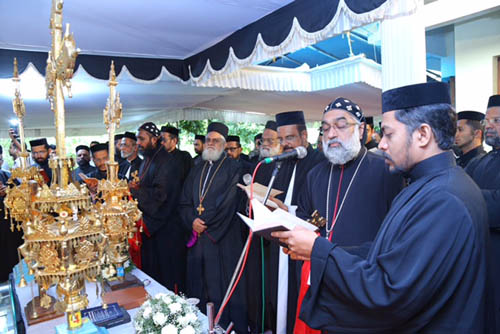 Achen's funeral services were attended by numerous bishops, priests, deacons,
and laity including several ministers, MLAs and other Civic leaders, teachers,
doctors, nurses, etc. etc. The funeral services were led by HG Joseph Mor
Gregoriose with assistance from HG Mathews Mor Ivaniose, HG Kuriakose Mor Dioscoros, HG Elias Mor
Athanasios, HG Elias Mor Yuliose, and numerous Cor Episcopas, Priests, etc. etc. His Beatitude Baseliose
Thomas I Catholicose and several other bishops visited the home and comforted
the family.
Achen's funeral services were attended by numerous bishops, priests, deacons,
and laity including several ministers, MLAs and other Civic leaders, teachers,
doctors, nurses, etc. etc. The funeral services were led by HG Joseph Mor
Gregoriose with assistance from HG Mathews Mor Ivaniose, HG Kuriakose Mor Dioscoros, HG Elias Mor
Athanasios, HG Elias Mor Yuliose, and numerous Cor Episcopas, Priests, etc. etc. His Beatitude Baseliose
Thomas I Catholicose and several other bishops visited the home and comforted
the family.
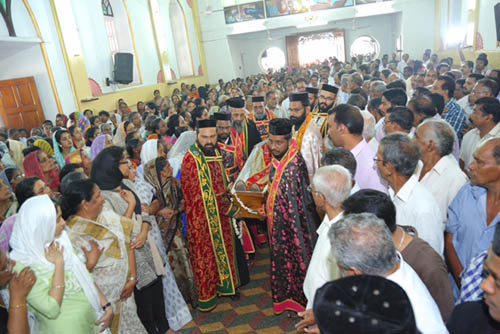 Body of Very Rev. Joseph Pukkunnel Corepiscopa is brought to St. Mary's Cathedral (Valiapally), Kothamangalam 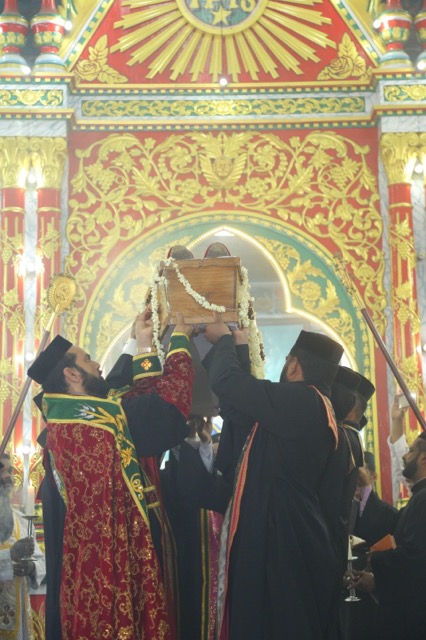 V. Rev. Joseph Pukkunnel bids farewell to the Madbaha
V. Rev. Joseph Pukkunnel bids farewell to the Madbaha he has served for the last time. 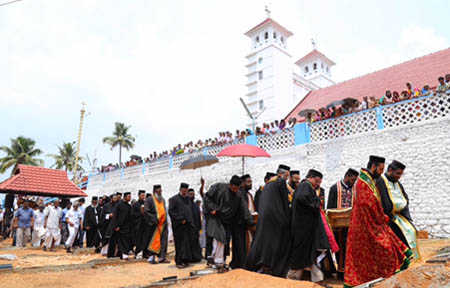 Procession with the Body of V. Rev. Joseph Pukkunnel
from
Procession with the Body of V. Rev. Joseph Pukkunnel
from St Mary's Cathedral (Valiapally), Kothamangalam to the Cemetery for Burial. Personal Reflections: Achen was a remarkable person. He was in Cleveland, Ohio about 20-years ago and spent a summer here with his son Jijo and daughter in law Sunitha. During this time, he conducted several church services in Cleveland and I got a chance to know achen, 'up close and personal.' What impressed me most about achen was the sermons he delivered. They were well prepared. He was a good story teller. He sprinkling some humor, and, like Jesus' parables, explained the biblical passages with the contemporary experiences. I had wrote notes and published them on our website - internet was new at that time. He was very humble. He protested, "I am just an ordinary priest. These will be seen all over the world!" That is what I call humility! I still refer to his sermons and often quote a passage achen talked about St. Mary's encounter with angel Gabriel. I must have heard at least 1000 sermons since then and read many times more for Malankara World. So, the fact that I can still recall his sermons can tell you the quality of them and their impact on me personally. Myself and my wife Shila had the great fortune to visit achen and Kochamma a few years back (2012). We spent nearly 4-5 hours with them. They were the perfect hosts. Achen told Kochamma, after giving a list of foods, "The Americans will like these kind of food so, make some more." We were stuffed when we left. Had eaten all my favorite fruits there. Achen knew exactly what we liked!! They were the perfect hosts. 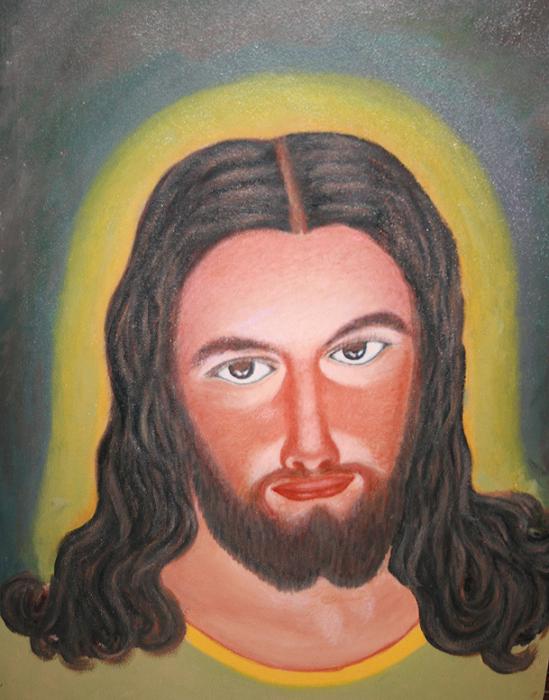 A Painting by V. Rev. Joseph Pukkunnel
I saw Achen's collection of paintings and many paintings in various stages of
completion. Achen was also an expert in wood carving. He had built and donated
to churches several carved furniture. (see an example below.) Like Da Vinci, achen's talents were multi
dimensional and remarkable.
A Painting by V. Rev. Joseph Pukkunnel
I saw Achen's collection of paintings and many paintings in various stages of
completion. Achen was also an expert in wood carving. He had built and donated
to churches several carved furniture. (see an example below.) Like Da Vinci, achen's talents were multi
dimensional and remarkable.
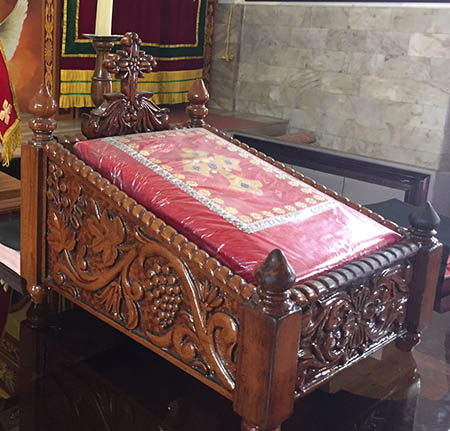 Furniture Carved by V. Rev. Joseph Pukkunnel
He had designed a great drainage system for the house and explained to me how
that worked. I was floored!
Achen was a Syriac scholar. When we met him, he was translating several rare
Syriac manuscripts for the seminary.
Achen also built 4-6 new churches; he acted many roles in the construction of
those churches including that of a
General Contractor and stayed at the construction site from sunrise to sunset.
In addition to these, he had rebuilt several others.
I have just started. But you get the idea. He was one of the most remarkable
persons I have the pleasure of knowing.
Achen's departure is a big loss to our church.
May God grant him a spot in the bosom of Abraham, Issac and Jacob.
Acknowledgements:
We express our thanks to Jijo Flowerhill for photographs and biographical
information on achen.
Furniture Carved by V. Rev. Joseph Pukkunnel
He had designed a great drainage system for the house and explained to me how
that worked. I was floored!
Achen was a Syriac scholar. When we met him, he was translating several rare
Syriac manuscripts for the seminary.
Achen also built 4-6 new churches; he acted many roles in the construction of
those churches including that of a
General Contractor and stayed at the construction site from sunrise to sunset.
In addition to these, he had rebuilt several others.
I have just started. But you get the idea. He was one of the most remarkable
persons I have the pleasure of knowing.
Achen's departure is a big loss to our church.
May God grant him a spot in the bosom of Abraham, Issac and Jacob.
Acknowledgements:
We express our thanks to Jijo Flowerhill for photographs and biographical
information on achen.
|
|
Malankara World Journal is published by MalankaraWorld.com
http://www.MalankaraWorld.com/
Copyright © 2011-2019 Malankara World. All Rights Reserved. |